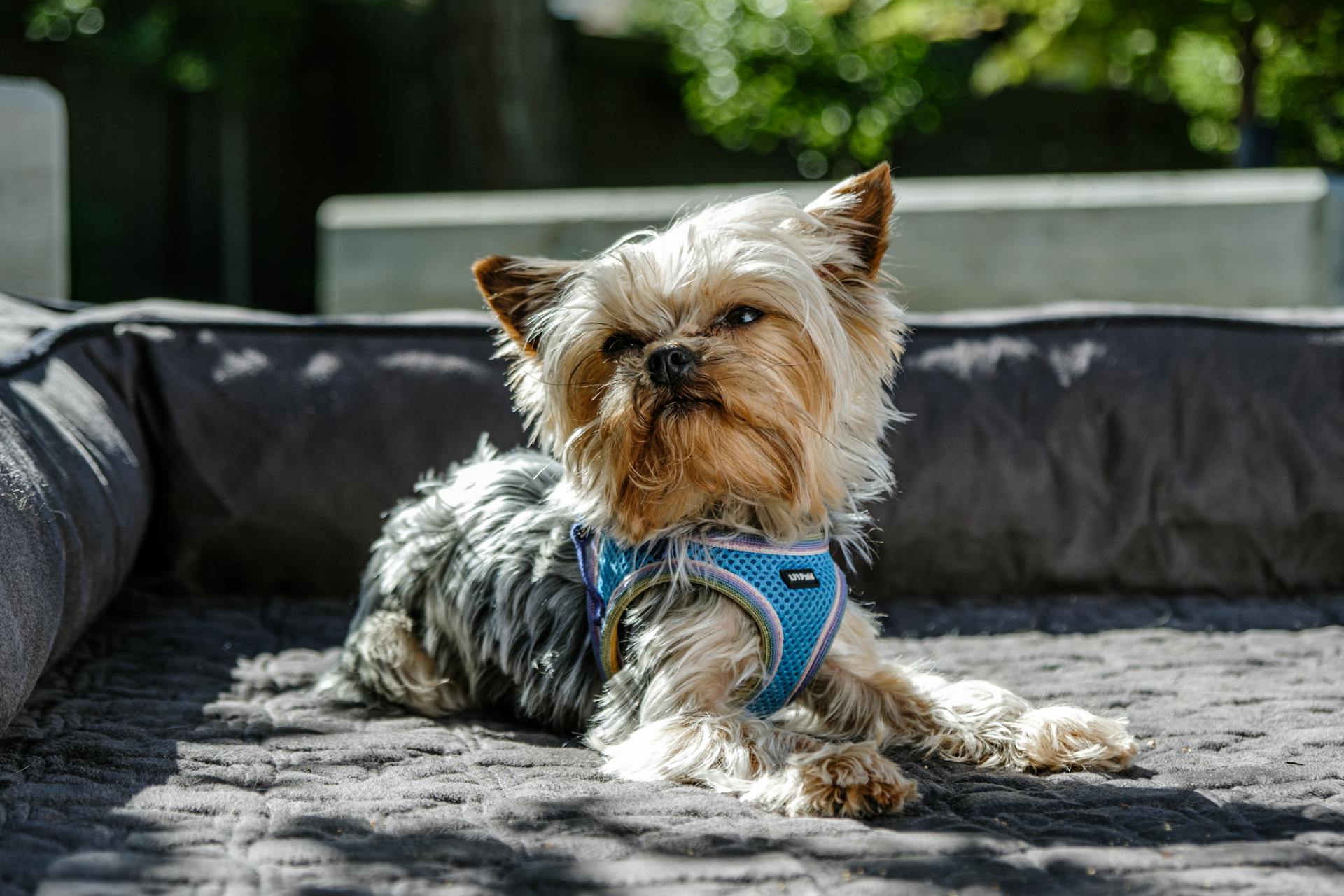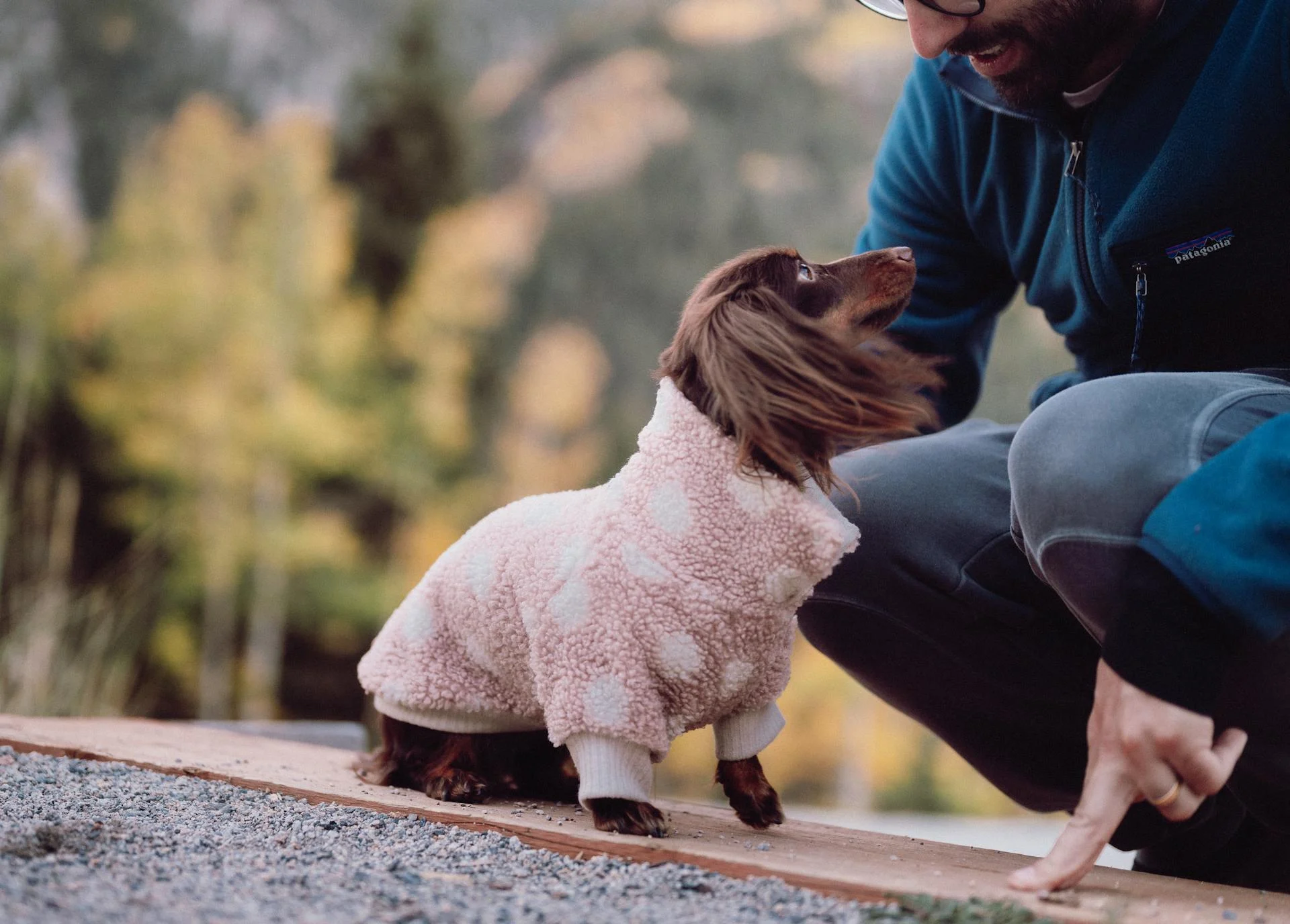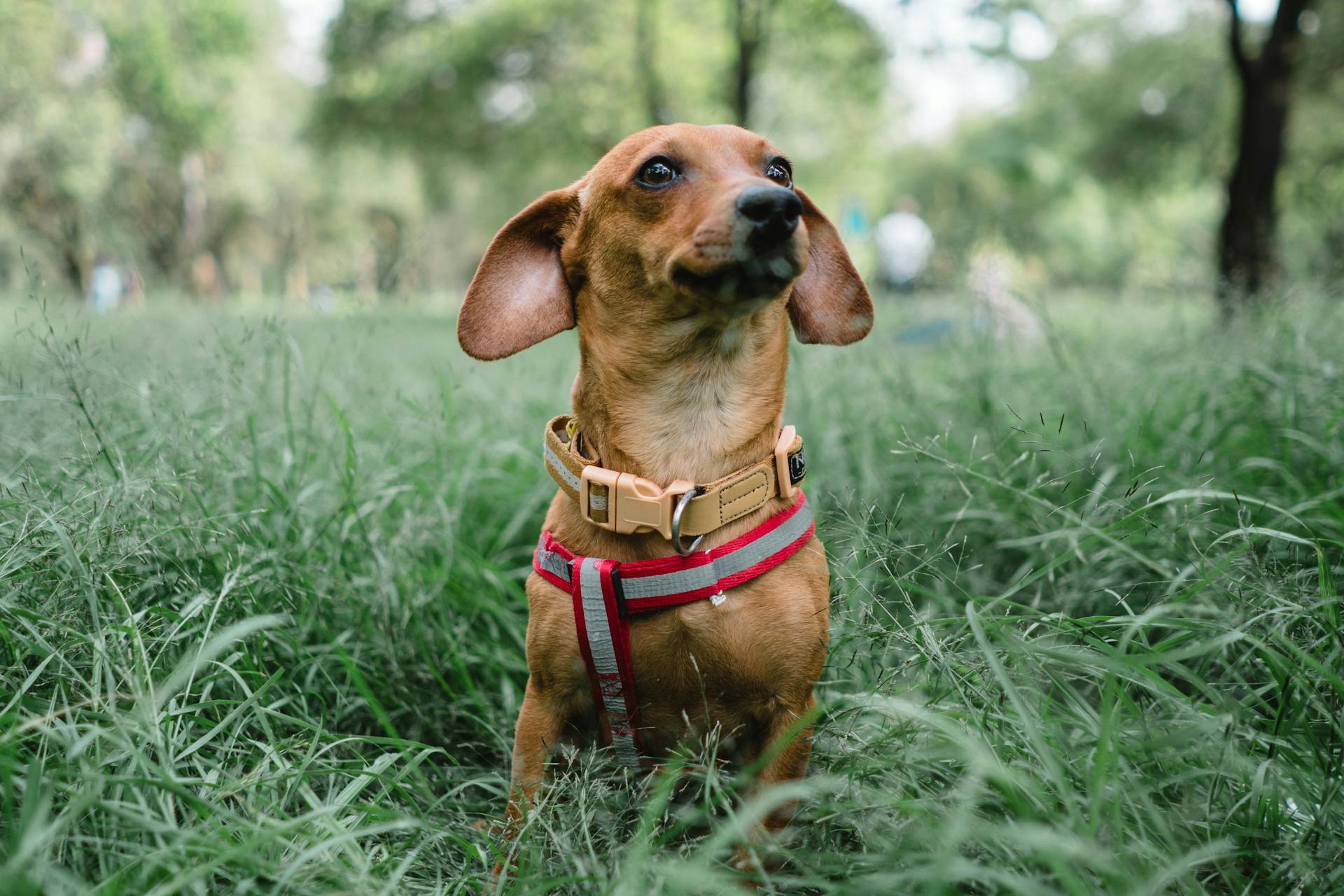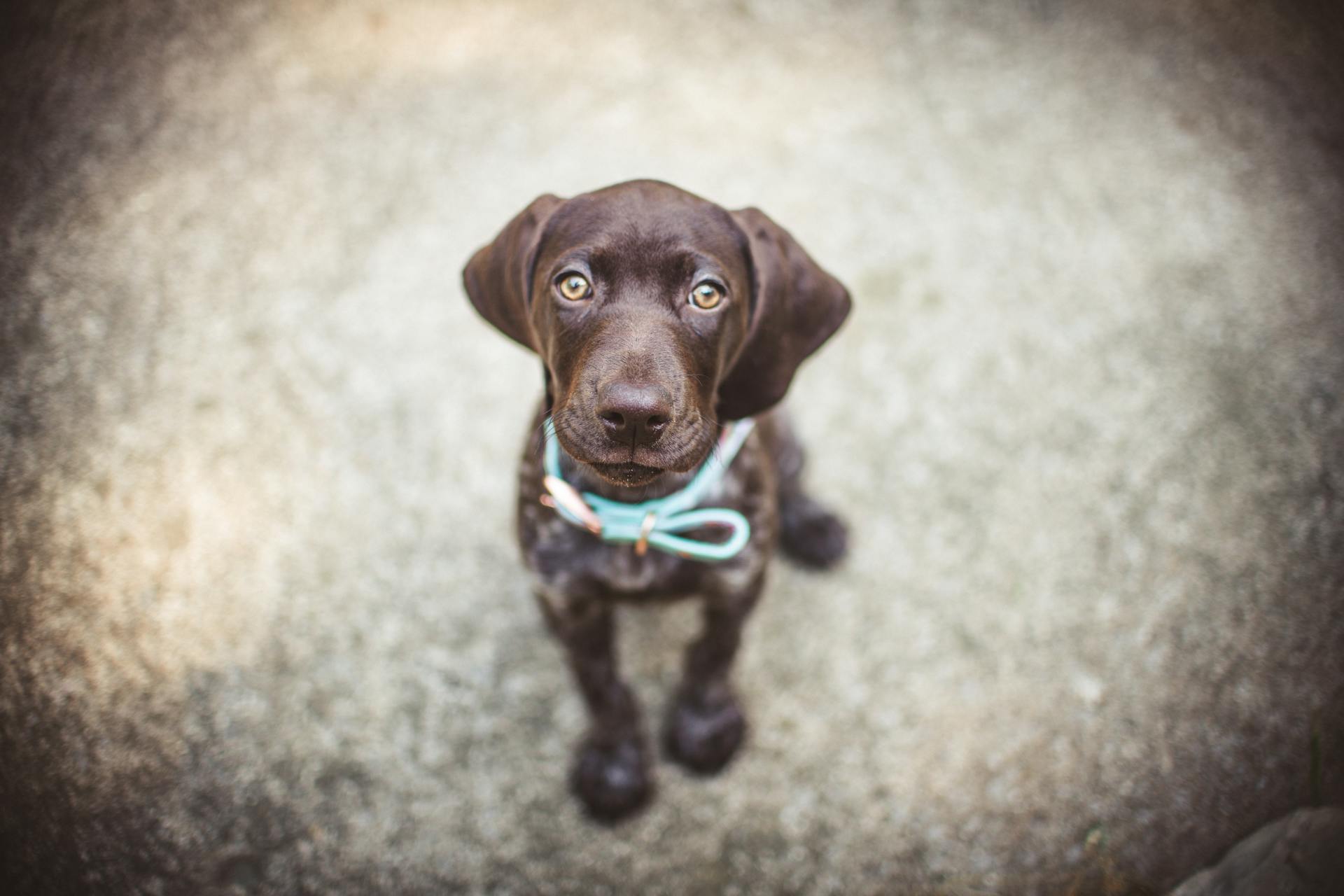
Ivdd Dachshunds can be a serious health issue for these lovable dogs. The condition, also known as Intervertebral Disc Disease, affects the spine and can cause a range of problems.
The main cause of Ivdd in Dachshunds is their unique body shape, which puts pressure on their spine. This can lead to a herniated disc, which can be extremely painful for the dog.
Dachshunds are prone to Ivdd because of their long, narrow spines and short legs. This makes them more susceptible to back problems.
Symptoms of Ivdd in Dachshunds can include pain, weakness, and paralysis.
Diagnosis and Treatment
If your Dachshund is showing signs of Intervertebral Disc Disease (IVDD), it's essential to get them checked by a veterinarian as soon as possible.
A veterinarian will examine your dog, taking note of any pain or reluctance to move. They may also perform imaging tests, such as X-rays or an MRI, to confirm the diagnosis.
If your Dachshund is experiencing severe back pain or weakness in their back legs, they may need immediate surgery to prevent further damage.
In some cases, surgery may be necessary to relieve pressure on the spinal cord and prevent permanent paralysis.
Here are some common symptoms that may require immediate veterinary attention:
- Down dog (dragging/no control of back legs and bladder)
- Weakness or uncoordinated in the back legs
Your veterinarian will work with you to develop a treatment plan that may include medication, physical therapy, or surgery, depending on the severity of the condition.
Managing Episodes
If your Dachshund is experiencing an IVDD episode, it's essential to keep them immobile and in a crate right away to prevent further injury.
You'll need to visit your vet to assess the situation and determine the severity of the episode. They'll help you figure out if the disc is pushing on the spinal cord or not.
If your Dachshund is down and not walking, surgery is usually the best option as soon as possible, ideally within 24 hours of losing deep pain sensation in their toes.
You can expect a 6-8 week period of healing and rehabilitation after an episode, during which your vet will prescribe a mix of pain killers and anti-inflammatories.
Consider reading: What Kind of Pain Reliever Can I Give My Dog
Signs & Symptoms

Managing episodes of Intervertebral Disc Disease (IVDD) requires being aware of the signs and symptoms. If your dog is whining, hiding under a bed, or squeals/whimpers when you pick them up, it could be a sign of IVDD.
Reluctance to move is another good indication. If your dog seems hesitant to move or out of the norm, it's essential to investigate further. In severe cases, dogs may be unwilling to move at all.
An arched back or head held high can be a sign of a problem with a disc in the neck. This is often a clear indication that something is amiss.
Weakness or uncoordinated movement in the back legs is a more severe symptom. If you notice your dog struggling to walk or stand, it's crucial to seek veterinary attention promptly.
Some common symptoms of IVDD include back pain, reluctance to jump or climb stairs, hunched posture, and sensitivity when touched along the spine. These symptoms can manifest in different ways, so it's essential to be aware of any changes in your dog's behavior or mobility.
Here are some key signs and symptoms to look out for:
- Pain (whining, hiding, squealing/whimpering)
- Unwillingness to move
- Arched back or head held high
- Weakness or uncoordinated movement in the back legs
- Reluctance to jump or climb stairs
- Hunched posture
- Sensitivity when touched along the spine
Physical Therapy
Physical therapy is a crucial part of managing episodes after an injury, especially for dogs that have undergone surgery. You should consult a rehabilitation-specialized veterinarian to determine the best course of action for your dog.
Managing pain is a key aspect of physical therapy, as it allows the body to heal more easily. The body heals faster when it's not in pain.
To help your dog recover, you can start with simple exercises like sit to stand. This helps work the back leg muscles, which is especially important after surgery.
Getting your dog to sit and stand up in little sessions a couple times a day can make a big difference in their recovery.
Related reading: Therapy German Shepherds
Dog Having an Episode - What to Do?
If you suspect your dog is having an IVDD episode, the first thing to do is keep them immobile and crate them right away.
You should visit your vet as soon as possible to assess the situation and determine if the disc is pushing on the spinal cord.

If your dog is down and not walking, surgery is often the ideal option, but it's crucial to act quickly, as the window for successful surgery is limited to 24 hours from the time they lose deep pain sensation in their toes.
If surgery isn't an option or you've chosen not to pursue it, your vet will prescribe a mix of pain killers and anti-inflammatories, and you'll need to allow a 6-8 week period of healing and rehabilitation.
During this time, your dog should be crate-rested, with only short potty breaks allowed, and you can start laser therapy and acupuncture right away.
You'll need to introduce controlled activity and exercise slowly, under the direction of a rehabilitation-specialized vet, to ensure your dog doesn't waste away muscle, but also allows scar tissue to form and the disc to heal.
If your dog does undergo surgery, you'll follow a similar plan, but can generally move things along a bit faster.
In the future, it's essential to follow precautions to prevent future episodes, such as keeping your dog at a healthy weight and avoiding strenuous activities.
Even if your dog can't walk, it's not a reason for euthanasia, and with the right care and support, they can live a fulfilling life in a wheelchair, or even regain mobility years later.
Expand your knowledge: How Much Exercise Do Dachshunds Need
Advanced Treatment Options
For Dachshunds with IVDD, surgery is often the best course of action to relieve pressure on the spine and prevent further damage.
Surgical options include a hemilaminectomy, which involves removing a portion of the vertebra to relieve pressure on the spinal cord, and a spinal fusion, which involves fusing two or more vertebrae together to stabilize the spine.
Physical therapy is a crucial part of post-operative care, helping to strengthen the muscles around the spine and improve mobility.
Exercise restrictions are essential to prevent further injury, and owners should work closely with their veterinarian to develop a rehabilitation plan that meets the dog's individual needs.
With proper care and attention, many Dachshunds can make a full recovery from IVDD and lead happy, healthy lives.
Worth a look: How to Prevent Ivdd in Dachshunds
Prevention and Research
Genetic testing can identify the IVDD mutation in Dachshund breeds, which can help breeders make informed decisions about breeding.
Early spaying or neutering can also reduce the risk of IVDD in Dachshunds, as it eliminates the production of sex hormones that can contribute to the growth of the spine.
Exercise and weight management are crucial for preventing IVDD in Dachshunds, as excessive weight can put additional strain on the spine.
Here's an interesting read: A Guide to Managing Healthy Weight in Your Dog This Summer
Preventing Disc Degeneration
Maintaining a healthy weight is crucial in preventing disc degeneration, as obesity puts extra strain on the spine, increasing the likelihood of disc herniation.
A balanced diet and regular exercise can help ensure your Dachshund stays at an appropriate weight.
Regular exercise is essential, but it's equally important to choose low-impact activities that strengthen muscles without putting undue stress on the spine, such as swimming or walking on soft surfaces.
Use ramps instead of stairs whenever possible, especially for dachshunds with long backs, to provide proper support and avoid activities that put excessive stress on your dog's back.
Traditional collars can strain the neck and exacerbate spinal issues, so opt for a harness that distributes pressure evenly across the chest and shoulders to minimize strain on the back.
By being vigilant and observing any changes in your Dachshund's behavior or mobility, you can catch early signs of disc degeneration, such as reluctance to jump or difficulty walking.
For another approach, see: Dogs Ears Back Tail Wagging
Research on Improving Intervertebral Disk Disease Recovery
Research on Improving Intervertebral Disk Disease Recovery is ongoing, with studies focusing on the use of stem cells to regenerate damaged disk tissue.
One promising approach is the use of mesenchymal stem cells, which have been shown to reduce inflammation and promote healing in animal models.
Researchers are also exploring the potential of platelet-rich plasma (PRP) therapy to stimulate disk regeneration.
PRP therapy involves injecting a concentrated solution of platelets and growth factors into the affected disk, which can help promote healing and reduce pain.
Studies have shown that PRP therapy can lead to significant improvements in disk health and function in patients with intervertebral disk disease.
Consider reading: Cushing's Disease in Dachshunds
Understanding IVDD Grades
Your dog's IVDD grade is a crucial piece of information that can help you understand the risk of your Dachshund developing clinical signs of the disease.
The grade is based on the number of calcifications present in your dog's spine, with higher grades indicating a higher number of calcifications and a greater risk of clinical signs.
See what others are reading: What Does It Mean When Dogs Wag Tail
Here's a breakdown of what each grade means:
- Grade 0: Your dog has no calcifications.
- Grade 1: One to two calcifications have been observed.
- Grade 2: Three to four calcifications have been observed.
- Grade 3: Five or more calcifications have been observed.
This information can help you and your veterinarian make informed decisions about your dog's care and management.
Causes of IVDD
Genetics play a significant role in the occurrence of IVDD, making Dachshunds more prone to developing weakened or degenerated discs in their spines.
Carrying extra pounds puts added stress on the spine and increases the likelihood of disc compression or rupture, which is why keeping your Dachshund at a healthy weight is essential.
Trauma can trigger IVDD in some cases, resulting from jumping off furniture, rough play, or accidents that cause injury to the intervertebral discs.
As dogs get older, their intervertebral discs naturally lose water content and become more brittle, making them susceptible to damage even with minimal trauma.
For another approach, see: Intervertebral Disk Disease in Dachshunds
What Does My Dog's Grade Mean?
Your dog's grade is a crucial indicator of their risk for developing clinical signs and passing the disease on to their offspring. The grade is determined by the number of calcifications present in the spine.
A grade of 0 means your dog has no calcifications, which is great news! This means they're less likely to develop clinical signs and pass the disease on to their puppies.
A grade of 1 or 2 indicates that one to four calcifications have been observed. This is still a relatively low number, but it's essential to keep an eye on your dog's health.
A grade of 3, on the other hand, means five or more calcifications have been observed. This is a higher risk, and it's essential to work closely with your veterinarian to monitor your dog's health.
Here's a quick reference guide to help you understand your dog's grade:
Typical Age?
Dogs are more likely to show signs of IVDD between 3 and 8 years of age. However, it's essential to remember that no dog is ever immune to this condition, regardless of age.
Typically, signs of IVDD appear when dogs are between 3 and 8 years old, which can be a concerning time for many pet owners.
Broaden your view: Signs of Ivdd in Dachshunds
Breeding and Genetics
IVDD is partly influenced by genetics, but the way it's inherited is not fully understood and can be unpredictable.
To reduce the chances of breeding puppies affected by IVDD, breeders can use guidelines that take into account the IVDD calcification grade of the parents.
These guidelines can help identify high-risk matings that should be avoided, such as those with a high risk of producing puppies that may grow up to be affected by IVDD, which are marked as "Red" in the breeding table.
You might enjoy: Are Dachshunds High Maintenance
DNA Testing Options
DNA testing can seem like a straightforward way to identify potential health issues in Dachshunds, but it's not always that simple. IVDD, in particular, is highly heritable but not a simple genetic disorder that can be tested for like other diseases.
DNA testing can be used to identify genetic mutations associated with certain health issues, but it's essential to understand what can and can't be tested for. IVDD Screening and the DNA Test for CDDY & IVDD sections provide more information on this topic.
A unique perspective: Dental Health Diets for Dogs
Breeding Advice
Breeding responsibly is crucial to reduce the risk of producing puppies affected by IVDD.
The way IVDD is inherited is not fully understood and is not always entirely predictable.
Using guidelines to breed puppies can help reduce the chances of breeding puppies affected by IVDD.
Breeding from screened dogs can reduce the risk of producing affected puppies.
The outcome of mating a male and female with a known IVDD calcification grade can be determined using a table.
Green indicates the lowest risk of breeding dogs affected by IVDD.
Amber indicates a higher risk of producing puppies that may grow up to be affected by IVDD.
Red indicates a mating that has a high risk of producing puppies that may grow up to be affected by IVDD.
These high-risk matings are not recommended due to the serious impact IVDD can have on a dog's health and welfare.
Types of Disc Degeneration
Intervertebral disc degeneration (IVDD) can be a real challenge for dachshunds, but understanding the types of degeneration can help us better care for our furry friends.
There are two main types of IVDD: non-chondrodystrophic (NCD) and chondrodystrophic (CD).
NCD IVDD is more common in younger dachshunds and tends to affect the upper spine.
CD IVDD, on the other hand, is more common in older dachshunds and tends to affect the lower spine.
NCD IVDD often presents with a sudden onset of paralysis or weakness in the hind legs.
CD IVDD can lead to a gradual decline in mobility and may cause chronic pain.
The intervertebral discs in dachshunds are prone to degeneration due to their unique body shape.
The risk of IVDD increases with age, with most cases occurring in dachshunds over the age of 5.
NCD IVDD tends to be more severe than CD IVDD, with a higher risk of paralysis.
CD IVDD, while less severe, can still cause significant discomfort and mobility issues.
Check this out: Canine Teeth Age Chart
Conclusion
IVDD is a serious health issue that affects many Dachshunds. It's essential for dog owners to understand the causes, symptoms, and treatment options to provide their furry friends with the best care possible.
Regular exercise, maintaining a healthy weight, and providing proper support during activities can minimize the risk of developing IVDD. Genetics and lifestyle choices are underlying factors that can contribute to IVDD.
Early detection and intervention are key to managing IVDD effectively. Seeking veterinary care immediately if your Dachshund experiences symptoms or has been diagnosed with IVDD is crucial.
Conservative management techniques like rest and medication, or more invasive procedures like surgery, may be treatment options for IVDD. By being vigilant about your Dachshund's health, you can give them the best chance at a comfortable life free from pain caused by IVDD.
Our beloved Dachshunds rely on us as their caretakers to prioritize their well-being.
Frequently Asked Questions
At what age do Dachshunds develop IVDD?
Dachshunds are most at risk of developing Intervertebral Disc Disease (IVDD) between the ages of 4 and 7. This age range is crucial for understanding the prevalence of IVDD in Dachshunds.
What are the odds of a dachshund getting IVDD?
Dachshunds are at high risk of developing IVDD, with 19-24% of the breed affected. Knowing the signs and symptoms can help you identify potential issues early on
What are the first signs of IVDD in Dachshunds?
Back pain is a common first sign of IVDD in Dachshunds, manifesting as reluctance to jump or climb stairs, hunched posture, or sensitivity along the spine. If left untreated, this pain can progress to partial or complete paralysis of the hind limbs
Can Dachshunds recover from IVDD?
Yes, Dachshunds can recover from IVDD, but the severity of the disease, classified as Type I or Type II, determines the likelihood and speed of recovery. Those with mild to moderate Type I disease often make a full recovery.
How do I stop my Dachshund from getting IVDD?
To reduce the risk of Intervertebral Disc Disease (IVDD) in your Dachshund, maintain a healthy weight and limit high-impact activities, such as jumping and rough play. This can help prevent spinal strain and reduce the likelihood of IVDD.
Sources
- https://celebritydachshund.com/pages/intervertebral-disc-disease-ivdd-in-dachshunds
- https://www.purinaproclub.com/resources/dog-articles/health/research-of-intervertebral-disk-disease-in-dachshunds-focuses-on-improving-recovery
- https://vetplayas.com/understanding-ivdd-in-dachshunds-causes-symptoms-and-treatment/
- https://ivdd.org.au/awareness/what-is-ivdd-2/
- https://www.thekennelclub.org.uk/health-and-dog-care/health/getting-started-with-health-testing-and-screening/ivdd-scheme-for-dachshunds/
Featured Images: pexels.com


